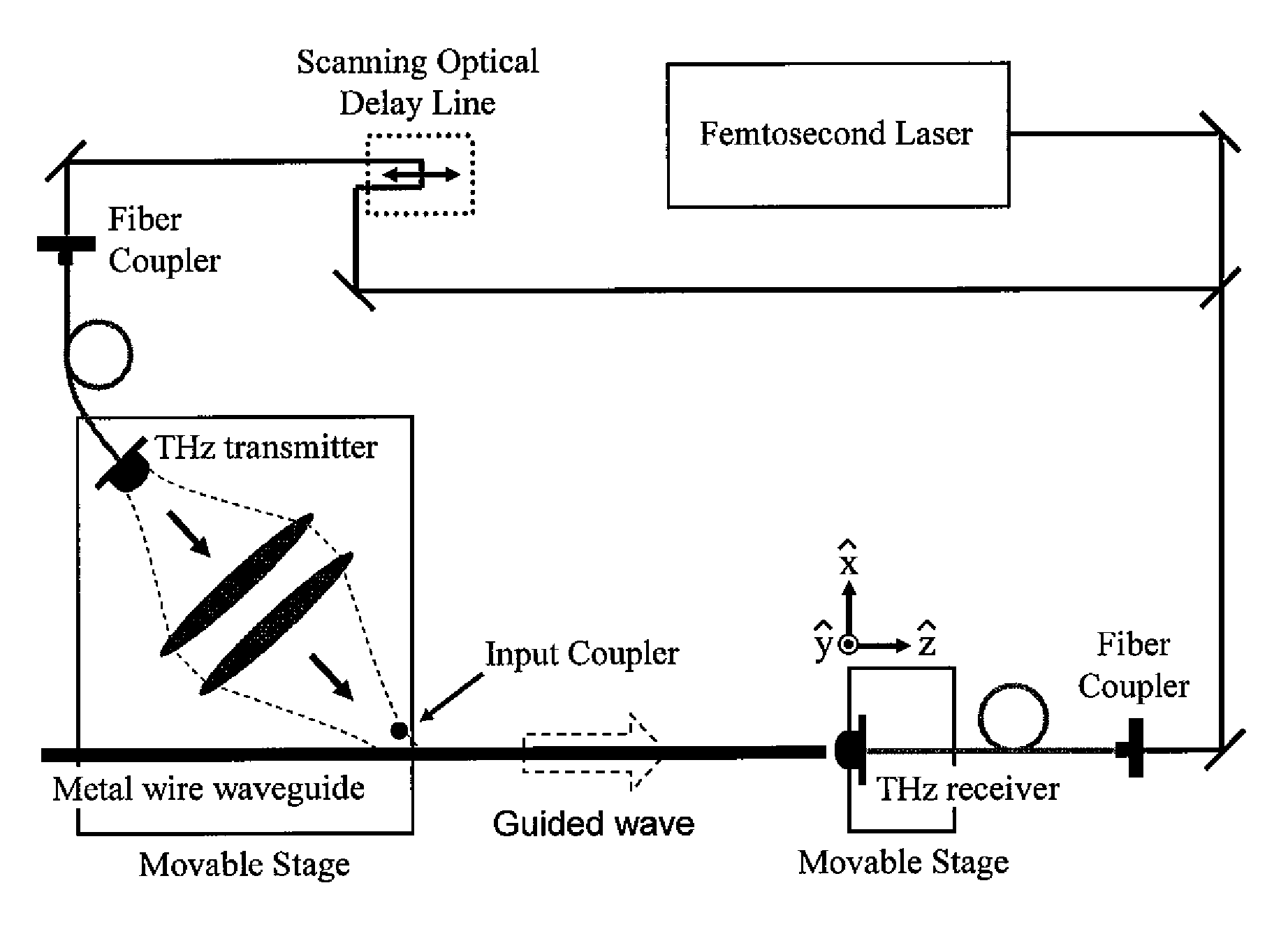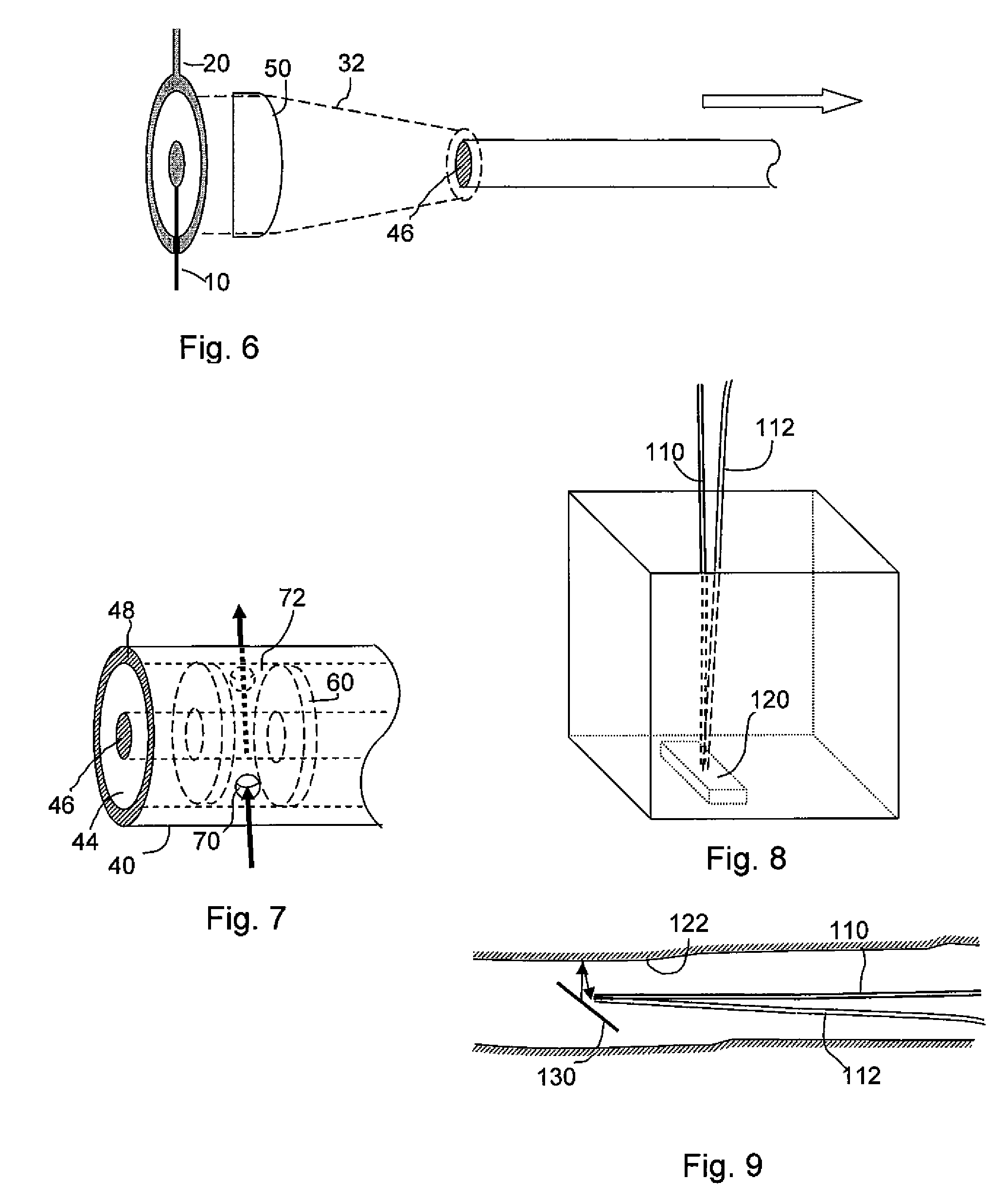Method and system for transmitting terahertz pulses
a terahertz pulse and beam technology, applied in waveguides, optical radiation measurement, instruments, etc., can solve the problems of limited progress, sample or region to be studied may not be readily accessible to a line-of-sight beam, and rely on free-space transport of terahertz beams. , to achieve the effect of low loss
- Summary
- Abstract
- Description
- Claims
- Application Information
AI Technical Summary
Benefits of technology
Problems solved by technology
Method used
Image
Examples
example 1
Propagation Effects in Near-Field Optical Antennas
[0078]The propagation of THz radiation along bare metal wires was first observed in the demonstration of apertureless near-field scanning optical microscopy (NSOM) using THz-TDS. The experimental setup is depicted in FIG. 12. The broadband single-cycle pulses of free-space THz radiation were generated using a photoconductive transmitter and were focused onto a beryllium-copper probe acting as an apertureless near-field optical antenna. The probe had a tip of about 25 μm radius and a shaft of 0.5 mm diameter coated with a thin layer of tin to prevent oxidation. The sample was a featureless gold-coated silicon wafer, placed in close vicinity of the tip. The mean distance between the tip and the gold surface, d˜350 nm, was precisely controlled by a piezoelectric transducer. In such a configuration, the tip strongly interacted with its image in the metal surface, and converted the localized evanescent field around the tip to propagating ...
example 2
Direct Characterization of a THz Wire Waveguide
[0081]For a better observation and characterization of the guided THz propagation on metal wires, we changed the experimental setup from the NSOM configuration to a new configuration in which the electric field of the guided mode was directly detected at the end of the waveguide. With the fiber-coupled transmitter and receiver, the incident position (the start point of the propagation) and the detection position of the THz pulses were changed to observe the spatial profile of the guided mode. A long stainless steel wire with a smooth surface, rather than the tiny tapered probe in the NSOM experiments, was used as the waveguide for the new measurements.
Experimental Setup
[0082]A schematic illustration of the new experimental setup is shown in FIG. 13. As in the NSOM experiments, the broadband single-cycle pulses of free-space THz radiation were generated and coherently detected using ultrafast photoconductive sampling. The horizontally po...
example 3
Manipulation of the Guided Pulses
[0093]The manipulation of the guided mode was next studied. The ability to direct radiation along curves is one of the most important features for a practical waveguide. The amplitude of THz pulses was compared after propagating on a waveguide bent with different radii. The results are shown by the hollow triangles in FIG. 18. The propagation distance was 21 cm, and the radius of curvature R was varied from 90 cm down to 20 cm in steps of 10 cm. The amplitude of the electric field E′ as a function of the propagation distance x along the bent waveguide is described by
E′(x)=E0e−α′x (6)
where α′ is the amplitude attenuation coefficient for a bent waveguide. By comparing equation (6) to equation (5) we find
α′=α+ln(EE′)x(7)
So the amplitude attenuation coefficient for each bend radius was extracted by comparing the amplitude of the detected THz pulse to that of a straight waveguide with the same propagation distance x. The extracted data are depicted by s...
PUM
 Login to View More
Login to View More Abstract
Description
Claims
Application Information
 Login to View More
Login to View More - R&D
- Intellectual Property
- Life Sciences
- Materials
- Tech Scout
- Unparalleled Data Quality
- Higher Quality Content
- 60% Fewer Hallucinations
Browse by: Latest US Patents, China's latest patents, Technical Efficacy Thesaurus, Application Domain, Technology Topic, Popular Technical Reports.
© 2025 PatSnap. All rights reserved.Legal|Privacy policy|Modern Slavery Act Transparency Statement|Sitemap|About US| Contact US: help@patsnap.com



